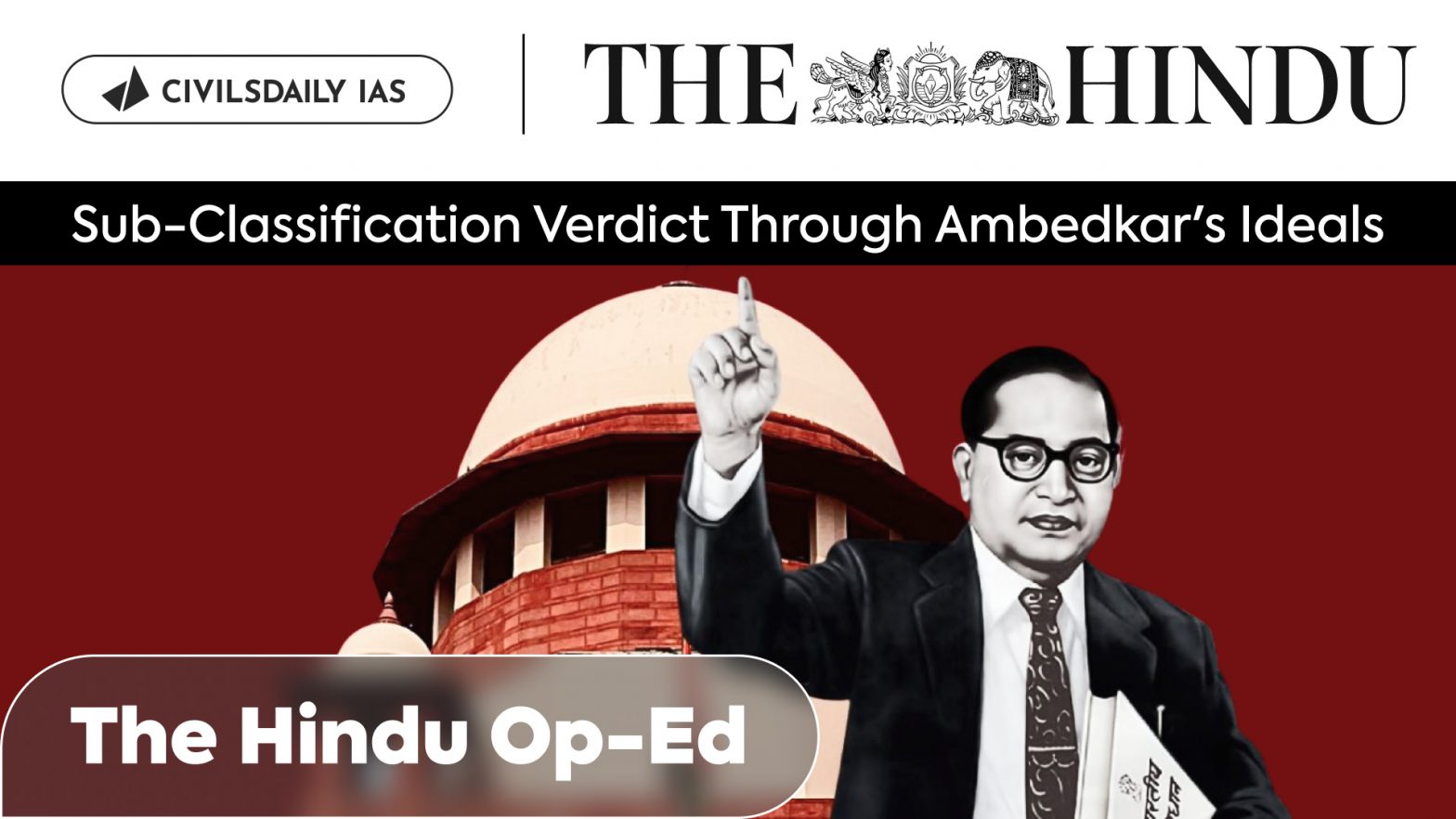| PYQ Relevance: Q Whether National Commission for Scheduled Castes (NCSC) can enforce the implementation of constitutional reservation for the Scheduled Castes in the religious minority institutions? Examine. (UPSC IAS/2018) Q What are the two major legal initiatives by state since Independence, addressing discrimination against Scheduled Tribes (ST)? (UPSC IAS/2017) Q ‘Constitutional Morality’ is rooted in the Constitution itself and is founded on its essential facets. Explain the doctrine of ‘Constitutional Morality’ with the help of relevant judicial decisions. (UPSC IAS/2021) |
Mentor comment: The recent verdict of the Constitution Bench of the Supreme Court upholding the legality of the sub-classification of Scheduled Castes (SCs) and Scheduled Tribes (STs) for the purpose of reservations has already created an avalanche of reactions, both positive and negative. The positive reactions are coming from die-hard, self-proclaimed progressives who are enamored with any phraseology that appears to favor the downtrodden, irrespective of the long-term impact of the decisions ensconced in that phraseology. The negative reactions are coming from the population that constitutes SCs, who stand accused of grabbing a disproportionate share of reservations. These population constituents are mainly arguing that sub-classification is not constitutionally permitted.
_
Let’s learn!
Why in the News?
The Supreme Court of India, in a landmark 6:1 majority judgment on August 1, 2024 in the State of Punjab & Ors. vs. Davinder Singh & Ors., upheld the permissibility of sub-classification of Scheduled Castes/Scheduled Tribes for reservation purposes, overruling the previous EV Chinnaiah judgment.
What are the main arguments against the sub-classification of SC/STs?
- Homogeneity Concerns: Critics argue that sub-classification undermines the uniform status of SCs and STs.
- The ruling aligns with B.R. Ambedkar’s ideas of fraternity and mutual respect among these communities. However, some believe that it oversteps the previous varna system.
- Potential for Inequality: There are fears that sub-classification could exacerbate existing inequalities
- For example, the concept of a “creamy layer,” refers to the more privileged individuals within these groups who may not need reservation benefits.
- Judicial Precedent: Previous Supreme Court rulings, such as in the E.V. Chinnaiah case, have held that SCs form a homogeneous group and that sub-classifying them for reservations violates constitutional provisions, particularly Articles 14 and 341.
| B.R. Ambedkar’s Fight for Social Justice: Dr. Ambedkar dedicated his life to achieving social and civil justice for the most oppressed groups, especially former untouchables. • High Caste Dominance: His efforts were often met with resistance from the traditional Hindu caste system, which did not adequately support his calls for cultural rights. Ambedkar pointed out that they should eliminate their internal divisions while fighting against untouchability. • Anti-caste Movements: He organized important movements, like the Mahad Satyagraha and the Kalaram temple entry movement, to challenge the discrimination faced by Dalits. Other learnings from History: • The present SC’s sub-classification judgment is a reflection of years of grassroots activism and demands by marginalized Dalit communities like Valmikis, Musahars, Madigas, and Arunthathiyars. • It is a testament to the ongoing struggle for justice led by organizations such as MRPS, Mang movements in Maharashtra, and the Valmiki movements in North India. |
Criticism and Support for Sub-Classification of Scheduled Castes
- Criticism and Causes: Some Dalit leaders fear sub-classification could diminish their political leverage and fragment the Dalit constituency, weakening the collective Dalit movement.
- For example, ‘Bharat Bandh’ called by some North Indian Dalit organizations was seen as a misstep that could affect the collective identity and mobilization of Dalit castes.
- Support and Causes: The debate around sub-classification has largely been resolved in South India, with most Dalit organizations supporting the demand for sub-categorization among SCs.
- Sub-classification could strengthen the collective identity of SCs, furthering the Ambedkarization process by including those on the margins.
- It aligns with the principles of equitable representation based on numerical strength, as leaders like Kanshiram advocate.
Conclusion:
Embracing this judgment with the spirit of fraternity, as Ambedkar envisioned, will be crucial in achieving a more just and inclusive society. The movement needs to broaden its focus beyond traditional reservation policies, advocating for extension to the private sector and pursuing land redistribution.

